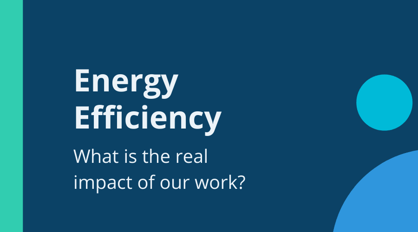
In October, we celebrated Energy Efficiency Day (October 6th) with a whole week dedicated to all things energy efficiency. Energy efficiency is the reduction of energy waste through the use of new technologies or improvements to existing systems. Through these improvements and upgrades, less electricity is needed to produce the same output as traditional technologies.
Whether your focus is on keeping up with new standards and regulations, cutting energy costs, or helping a customer achieve their social responsibility goals, this is probably a term that’s showing up in your day-to-day work more frequently. Despite most often being thought of in terms of financial savings, through both upfront incentives and annual energy bill savings, increasing energy efficiency also positively impacts carbon dioxide emissions, energy security, and the workforce.1
Cut CO2 Emissions
Energy efficiency can be improved through a number of measures including lighting upgrades, installation of control systems, building insulation and weatherization improvements, and the adoption of newer efficient technologies. Since less electricity is required to power energy-efficient buildings and systems, a significant carbon footprint reduction is also seen when these improvements are implemented. These improvements aren’t just low-impact though, with the availability of incentive programs to facilitate such projects, they’re also a cost-effective way to cut carbon emissions.
It might seem relatively small, but one kilowatt-hour (kWh) is equal to 0.0007 metric tons of carbon dioxide, this is equivalent to the greenhouse gas emissions from driving a passenger vehicle 1.8 miles.2 Even a small-scale project can have a large impact.
According to the American Council for an Energy-Efficient Economy (ACEEE), with increased policy efforts, energy efficiency has the potential to become the top electricity generation source by 2030, meeting up to one-third of our generation needs, or the equivalency of 487 power plants.3
Fig 1. Share of US electricity generation by resource in 2030, with increased energy efficiency policy3
Strengthening Energy Security
Reducing the need for additional power plants isn’t just beneficial for carbon emissions reduction, but is also instrumental in building a more flexible and resilient grid system. As a key Distributed Energy Resource, energy efficiency measures lessen reliance on fossil fuels and decrease the potential for service interruptions, since, “the only energy source that cannot be interrupted is the energy that is not used,” according to the International Energy Agency.4 In tandem with generation and demand response, energy efficiency has the capability to meet capacity at peak, providing more reliability, especially in the wake of severe storms and inclement weather.5
This will be essential as climate change drives more intense and frequent storm systems and environmental conditions.
Job Creation
As the energy efficiency sector grows and transforms, so does the need for an accompanying workforce. The 2018 study, Energy Efficiency Jobs in America, reports that the energy efficiency sector is the fastest growing in all of energy, employing 2.25 million people and adding the most jobs of any energy sector in 2017.6
These jobs are seen across a wide range of industries including manufacturing, sales and distribution, construction, and professional services. The sector doesn’t see signs of slowing down, with new energy efficiency technologies and solutions continuously being developed and a focus on energy efficiency as a generation source, the trajectory of employment in the sector will only continue to grow.
Conclusion
Along with your business goals, meeting regulations and customer needs are top priorities and can make it easy to forget about the bigger picture of the true impact of the work that we do in our industries. Energy efficiency has far-reaching impacts, bolstering the workforce, creating a more resilient and reliable grid, and reducing carbon emissions.
Remember this impact that you have and treat every day like it’s Energy Efficiency Day!
Sources
1 Natural Resources Defense Council
2 United States Environmental Protection Agency
3 American Council for an Energy-Efficient Economy
4 IEA (2019), Multiple Benefits of Energy Efficiency, IEA, Paris
.png?width=500&name=2019%20e%20news%20spotlight%20logo%20(1).png)



